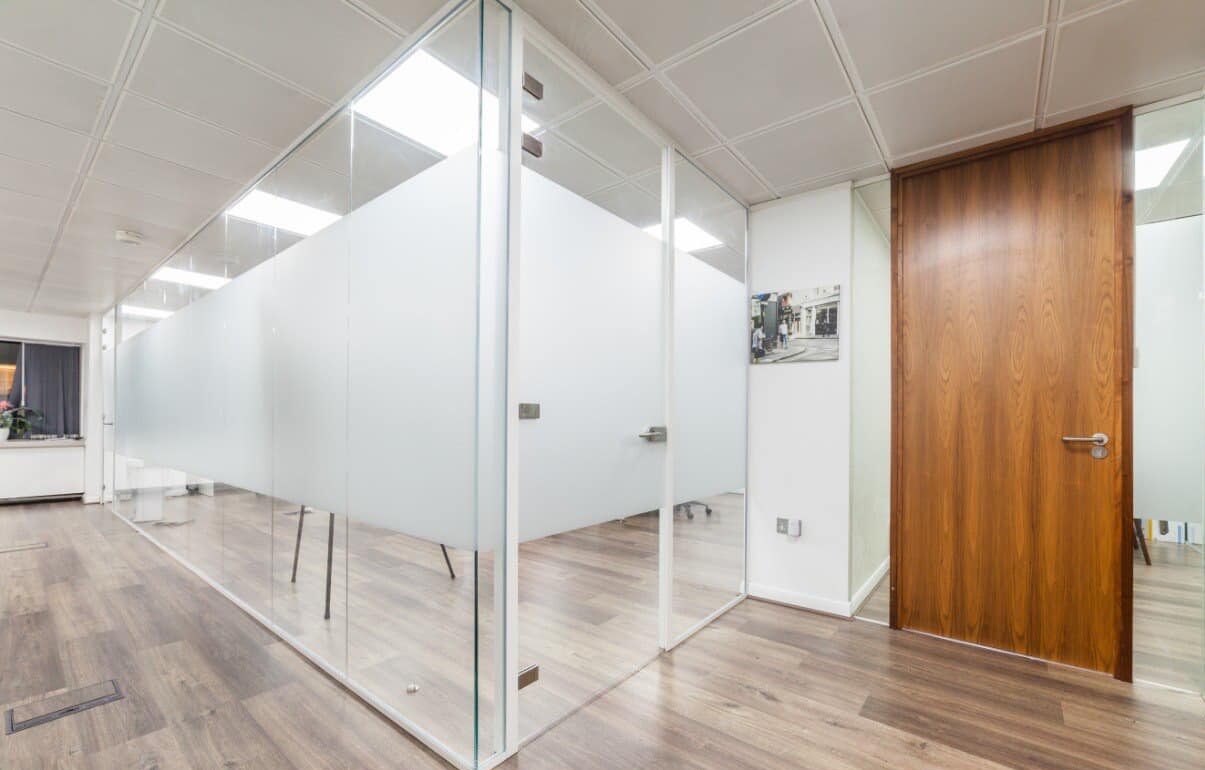
Interior design has moved far beyond simply filling rooms with furniture. Today, it’s about shaping how we experience space; how we move, work, focus, and relax. One of the most effective ways to do this, especially in modern environments, is with glazed partitions.
Glazed partitions are increasingly used in both residential and commercial interiors across the UK. From stylish home studies to quiet meeting zones in bustling offices, they serve as clean, light-enhancing dividers that support privacy, function, and visual flow.
This guide introduces you to the essentials of glazed partitions: what they are, the types available, where they work best, and why so many designers, business owners, and homeowners are choosing them to define and refine their spaces.
What are Glazed Partitions?
At their core, glazed partitions are internal wall systems made from safety glass. They are used to divide rooms or create enclosed zones. Unlike solid walls, they don’t close off visibility, which makes a space feel larger and more cohesive, even when split into multiple areas.
Glazed partitions are most commonly made from toughened or laminated glass and may be framed or frameless, clear or frosted, sliding or fixed. While they originated in commercial interiors like banks, corporate offices, and retail stores, they are now equally suited for private homes, creative studios, schools, co-working hubs, and healthcare settings.
Different Types of Glazed Partitions
1. Single-glazed systems
These use one layer of toughened or laminated glass in a simple frame or frameless channel. Ideal for light separation where noise control is less critical, they’re often used in offices, corridors, or to divide breakout zones in commercial interiors. common features are slim design, budget-friendly, and quick installation.
Explore: Single Glazed Partitions
2. Double-glazed systems
These include two glass panels separated by a gap, which can be left open or filled for better insulation. This structure greatly improves acoustic performance and adds strength, making them ideal for private offices, meeting rooms, or high-traffic spaces. Additional options are Integrated blinds, custom coatings, acoustic seals.
Explore: Double Glazed Partitions
3. Frameless glazed partitions
Frameless panels are held in discreet aluminium or steel channels, giving the appearance of floating glass walls. Favoured in design-led interiors, they deliver a clean look while keeping divisions nearly invisible. They are typically used in contemporary homes, design studios, and executive suites.
Benefits of Using Glazed Partitions
1. Enhance natural lighting
One of the most immediate and noticeable advantages of glazed partitions is how effectively they distribute natural light. In homes and offices where daylight is limited to perimeter walls, glass allows that light to travel deeper into interior rooms. This not only reduces reliance on artificial lighting but also has a direct impact on human well-being.
2. Improve acoustic insulation
While they allow visibility, glazed partitions, particularly those using laminated or double-glazed systems can offer meaningful sound insulation. This makes them an ideal solution for separating spaces that require focus or discretion.
3. Flexible space management
Glazed partitions enable you to organise space without committing to fixed layouts. Unlike permanent walls, they can be reconfigured, removed, or adapted as your needs change, making them a practical choice for growing teams, home renovations, or changing tenancy needs.
Practical Considerations Before Installation
Choosing the Right Type
Selecting the right glazed partition system depends on a combination of functional and aesthetic factors:
1. Budget: Single-glazed and framed systems are generally more affordable than double-glazed or frameless options.
2. Acoustic needs: If sound control is a priority, opt for double-glazed or laminated glass with acoustic seals.
3. Aesthetic goals: Frameless systems offer a clean, minimalist look. Framed options, such as black steel or timber borders, provide a bolder visual or industrial finish.
Tips for evaluation:
Start by defining how the space will be used. Is the goal to create a quiet room? Increase visual connection? Add flexibility? Once you’ve defined the purpose, consider layout constraints, lighting conditions, and surrounding design elements. If in doubt, speak with our team so we can guide you on building conditions and usage goals.
Regulations and Standards in the UK
Installing glazed partitions, especially in commercial or public buildings, requires attention to several UK standards. These ensure your installation is safe, effective, and compliant with building codes.
Key areas to be aware of include:
1. Fire safety: Partitions in corridors or escape routes may need to be fire-rated (typically rated to 30 or 60 minutes).
2. Acoustic requirements: Many commercial projects require proof of sound reduction, especially in schools, healthcare, and office settings.
3. Glass safety: All systems must use safety-rated glass (BS EN 12150 for toughened glass or BS EN 12600 for impact performance).
4. Accessibility & visibility: In public areas, manifestations such as dots or lines on glass are required to prevent accidents.
It’s essential to consult with us at Kova Partitions to ensure your system meets the appropriate criteria for its intended use.
Maintenance and Durability
Glazed partitions are low maintenance by design, but routine care helps preserve their appearance and function.
1. Cleaning: Use non-abrasive, ammonia-free glass cleaners to remove fingerprints, dust, or smudges.
2. Hardware checks: For sliding or door-integrated systems, inspect tracks and hinges every 6–12 months. Lubricate where needed to prevent stiffness or wear.
3. Seal integrity: Over time, seals may degrade in humid or high-traffic environments. Replace them if you notice drafts, condensation, or loosening panels.
With proper care, glazed partitions can remain in excellent condition for 15 to 25 years, depending on usage and environmental exposure.
Quick Comparison of Glazed Partition Types
| Partition type | Cost range (per m²) | Acoustic performance | Best use cases |
|---|---|---|---|
| Single-glazed | £250 – £500 | Moderate | General office zones, internal room dividers |
| Double-glazed | £450 – £800 | High | Boardrooms, private offices, home workspaces |
| Frameless glass | £350 – £700 | Moderate | Design-led homes, galleries, executive spaces |
| Framed glass (e.g. black grid) | £400 – £750 | Moderate to high | Industrial-style offices, urban flats |
| Acoustic-rated systems | £600 – £1000+ | Very high | Recording rooms, schools, medical facilities |
Note: Pricing may vary based on customisation, installation complexity, and location.
Installation Process – Step by Step
1. Site assessment & measurement: We begin by visiting your site to assess the layout, structural features, and any access limitations. Accurate measurements are taken to ensure a perfect fit and to identify any bespoke requirements early on.
2. System specification & planning: Based on your layout and goals, whether acoustic control, privacy, or visual style, we help you choose the ideal partition type, glazing thickness, frame finish, and any necessary fire-rated or acoustic components.
3. Fabrication & preparation: Once specifications are confirmed, we coordinate the production of your system. Glass panels are cut, polished, and treated; if frosted, tinted, or printed, and framing or hardware is prepared for delivery.
4. On-Site preparation: Our team installs track systems, floor channels, or framing structures in line with the design plan. This step is crucial for alignment and durability, especially for frameless or ceiling-mounted systems.
5. Glass panel installation: Panels are delivered, handled with specialist lifting equipment, and secured in place. We carefully install all joints, seals, and doors, making sure everything functions exactly as intended.
6. Final check, finishes & client sign-off: We carry out a full quality check, verifying alignment, movement, seal integrity, and finish. After cleaning the glass and removing any protective film, we hand over the completed space and walk you through any aftercare or maintenance advice.
Final Thoughts
Glazed partitions bring together style, function, and flexibility. Whether you’re designing a private home office, dividing a creative studio, or building out a new workplace layout, they offer a future-ready way to define space without shutting it down.
They suit a wide range of interiors, are easy to maintain, and when planned and installed properly, will serve your space for years to come. If you’re looking for an adaptable, light-friendly, and professionally finished room divider, glazed partitions are an excellent place to start.
FAQs
A glazed partition is an internal wall or divider made from glass, often used to separate spaces while maintaining visibility and light.
.
Yes, especially double-glazed or acoustic-rated systems, which help reduce sound transfer between rooms.
Costs vary based on glazing type, framing, and features like acoustic upgrades or privacy films. There are both affordable and premium options available.
Generally, no. Most internal glazed partitions fall under permitted development, but check with your local authority if you’re working in a listed building or regulated space.
High-quality glazed systems can last 20+ years, particularly when cleaned and maintained regularly. They’re a long-term solution for both homes and offices.














